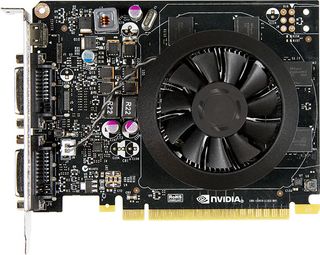GeForce GTX 750 Ti Review: Maxwell Adds Performance Using Less Power
Nvidia's GeForce GTX 750 Ti Reference Card
If you’re building a graphics card, dropping a low-power GPU onto it gives you some options. You don’t get shoehorned into a dual-slot, actively-cooled beast of a board. For its reference design, Nvidia chose a PCB less than six inches long—it pretty much ends with the PCI Express slot connector. There’s a single-slot I/O bracket with two dual-link DVI connectors and a mini-HDMI output. However, Nvidia covers the GM107 processor with an orb-style heat sink and fan that eat up two slots worth of space, so you still have to budget accordingly.

The card’s 60 W ceiling is easily satisfied by a 16-lane PCI Express slot, which is rated for up to 75 W. That means you won’t find an auxiliary power connector on the PCB (even if there are holes for one). We’ve long been fans of cards fitting this profile because of how flexible they are. Previously, AMD’s Radeon HD 7750 was your best bet for upgrading an old decrepit box with too-little power output or not enough connectors for a decent add-in board. Now the GeForce GTX 750 Ti is gunning for that position.
Nvidia's GK106-based GeForce GTX 660 is the card we're recommending around the $200 mark; AMD's Radeon R9 270 is just too pricey in comparison. This board from Gigabyte, overclocked from the factory, is a favorite.
Unfortunately, there’s also no SLI bridge connector. True to Nvidia’s mainstream approach, the $150 price point is right about where you lose the option to sling two boards together for higher performance. This is a competitive disadvantage; AMD’s alternatives in the same price range allow CrossFire configurations. It’s probable that Nvidia could achieve SLI over PCI Express, but the company says it doesn’t see much demand from enthusiasts looking to link $150 cards. If you feel differently, speak up. We’d be curious to see if a couple of GM107s could beat a GeForce GTX 770, for sure.

Nvidia plans to offer two versions of the GeForce GTX 750 Ti—one with 1 GB of GDDR5, priced at $140, and available later in February, and a 2 GB model that should be selling for $150 by the time you read this. Moreover, there will be a GeForce GTX 750 that ships later in the month at a price point of $120.
The initial round of partner boards includes a mix of cards eating up one and two expansion brackets, but they’re all dual-slot designs. Down the road, though, we’re told to expect dual-slot passively-cooled solutions. Single-slot configurations are also possible, though nobody seems certain that a low-profile fan can yield a pleasant experience.
Stay on the Cutting Edge
Join the experts who read Tom's Hardware for the inside track on enthusiast PC tech news — and have for over 25 years. We'll send breaking news and in-depth reviews of CPUs, GPUs, AI, maker hardware and more straight to your inbox.
Current page: Nvidia's GeForce GTX 750 Ti Reference Card
Prev Page Introducing The GM107 GPU, Based On Maxwell Next Page MSI GTX 750 Ti Gaming OC-
meluvcookies on performance, I'll take the extra frames of the 265, but damn, for 60w, I'm totally impressed by this card. both the 750Ti and the R7 265 would be decent upgrades from my aging GTX460.Reply -
s3anister ReplyBut without the big cooler, GTX 750 Ti is daintier than a lot of sound cards we've tested.
I'm pretty sure you meant to type "video cards" on page one there. Cheers. -
Bloob AlsoReplyIt’s difficult to make this story all about frame rates when we’re comparing a 60 W GPU to a 150 W processor
Is a bit confusing. -
cangelini Reply
Actually meant sound card :) It's definitely smaller than a small video card, but I even have sound cards here that are larger.But without the big cooler, GTX 750 Ti is daintier than a lot of sound cards we've tested.
I'm pretty sure you meant to type "video cards" on page one there. Cheers. -
Sangeet Khatri Well.. there is not a lot of performance in it, but I love it for a reason that it is a 60W card. I mean for 60W Nvidia has seriously nailed it. The only competition is way behind, the 7750 performs a lot less for similar wattage.Let's see how AMD replies to this because after the launch of 750Ti, the 7750 is no longer the best card for upgrading for people who have a 350W PSU.I don't generally say this, but Nvidia well done! Take a bow.Reply -
houldendub Nice little card, awesome! I feel like this would be an absolutely awesome test bed for a dual chip version, great performance with minimal power usage.Reply -
thdarkshadow The whole time I was reading the review I was like it isn't beating the 650ti boost... :( but then I remembered it uses less than half the power lol. I am impressed nvidia. While I make purchases more on performance than power consumption I can still appreciate what nvidia is doingReply -
houldendub Reply12707408 said:Anybody else notice the lesser shaders and TMUs on the Zotac card in GPU-Z?
Don't take this as fact, but the drivers look newer for the Zotac card than the others, possibly just a bug with the older drivers? The cards are advertised as having 640 shaders anyway.
Also weird, the GPU-Z screenshot is taken with Windows 8, whereas the Gigabyte and MSI cards are on Windows 7. The mystery continues...
Most Popular

